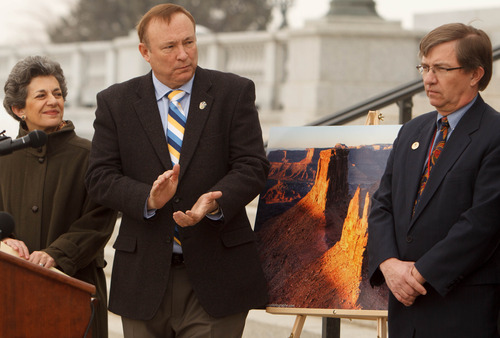This is an archived article that was published on sltrib.com in 2013, and information in the article may be outdated. It is provided only for personal research purposes and may not be reprinted.
Washington • Former Interior Secretary Bruce Babbitt challenged President Barack Obama to make "vigorous" use of the Antiquities Act to preserve treasured landscapes and pare down the rush to lease public lands for oil and gas drilling.
Babbitt, who headed the Interior Department when President Bill Clinton used that act to designate the Grand Staircase-Escalante National Monument in Utah, said Obama must make up for the lack of land preservation in his first term and can't try to compromise with House Republicans who have stalled any effort to name new wilderness.
"The idea that you can civilize these people by making concessions is entirely wrong," Babbitt said. "All it does is up their demands for more. The best defense of the Antiquities Act is to use it. And the reason for that is by using it, we show the American people what we have and what the program is for protecting it."
Clinton's use of the century-old power in 1996 to unilaterally name the Grand Staircase monument enraged many southern Utah residents and Utah politicians who got little notice and no say in the matter. It's still a sore subject to residents of the area.
But Babbitt said preservation of federal land is a popular move, and one that unlike gun control, gay rights or immigration reform, isn't controversial with the American public.
He pointed to a 2011 poll by Republicans for Environmental Protection that showed 69 percent of Utahns thought the Grand Staircase monument was good for the state, and that 62 percent of those polled said it was good for the economy.
Babbitt also said the president should set a goal of preserving one acre for every acre leased for energy exploration. And the former Interior secretary challenged the administration to set goals for setting aside public land every year and to suspend oil and gas lease sales if those goals aren't met.
"I think it's a way to get past the obstructionists in the House," Babbitt said.
Last November, the Outdoor Industry Association and more than 100 outdoor-related businesses sent a letter to Obama asking that he designate the Greater Canyonlands area as a national monument.
The Greater Canyonlands area includes geologic landmarks such as Labyrinth Canyon, Indian Creek, White Canyon, Fiddler Butte, Robbers Roost, Lockhart Basin and the Dirty Devil River.
Rep. Chris Stewart, a Utah Republican whose district includes the Grand Staircase monument, said the specter of using the Antiquities Act was a "horrible idea."
"It circumvents the will of the people, it circumvents the authority of the state and the counties and it's not the intention of the Antiquities Act," Stewart said, noting that he welcomes the idea of being called an obstructionist in blocking more federal land from being put off-limits.
"The obstructionists in the House, we have a role," Stewart said. "We're representing our district, we're representing our state and our district doesn't want another however-many-millions-of-acres pulled away from local control and given to the federal government."
Stewart's Utah colleague, Rep. Rob Bishop, who heads a House subcommittee overseeing public lands, says he's fine with the idea of setting aside one acre of wilderness for one acre of oil and gas leases — as long as the federal government makes them even to start.
"I think it's a great idea as long as we start with parity because we have 293 million acres in conservation right now and only 37 million acres that are in oil and gas, and only a half million acres have disturbance on them," Bishop said off the House floor. "So if he [wants to bring] us up to parity, I think it's a good idea doing a one for one."
Bishop and his Utah Republican colleagues sponsored legislation in the last two sessions of Congress that would exempt Utah from the Antiquities Act, though the measure never made it to a vote.
That legislation was prompted by a partial memorandum that Bishop obtained showing potential monuments across America, including two in Utah. Interior Secretary Ken Salazar had said at the time that memo was for discussion only.



